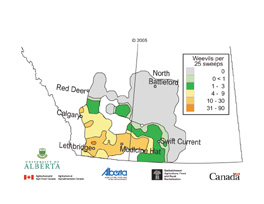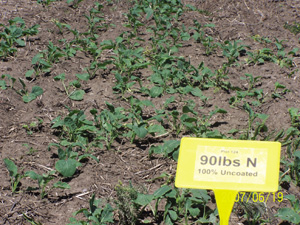
Features
Agronomy
Seeding/Planting
Urea treatments may allow one pass single shoot seeding
ESN urea and Agrotain-coated urea show promise for one pass seeding without banding.
March 5, 2008 By Bruce Barker
 |
| ESN urea at 90 pounds per acre. Photos Courtesy Of Ken Coles, SARA. |
It might be nice to sell the banding equipment, or ditch the heavy-pulling side-band openers. Research into coated urea treatments is helping to determine whether single shoot seeding is possible. “A lot of no-till farmers with single shoot systems are banding fertilizer in a separate operation in the fall or early spring. The concern is seedling damage from applying fertilizer with the seed, especially when the soil is dry,” explains Don Wentz, agronomist with Alberta Reduced Tillage Linkages (RTL) at Lethbridge. “A technology like Environmentally Smart Nitrogen (ESN) urea might help eliminate that extra banding operation.”
ESN is the new kid on the block. It is a controlled release fertilizer consisting of a polymer coated urea. The polymer coating allows water to diffuse into the granule, dissolving the N within. The rate of N release through the coating is then governed by soil temperature. Because the N release is slower in the spring when seed-placed in a single shoot system, there should be less seedling damage.
Another product, Agrotain has been on the market for a few years. Agrotain-treated urea prevents seedling damage by slowing the conversion of urea to ammonia through the use of a urease inhibitor. Ammonia is the form of N that causes seedling damage. Previous research, and information published by Agrotain International, indicates that using Agrotain-treated urea allows fertilizer rates to be increased by up to 50 percent compared to provincial recommendations.
Several studies across the prairies have looked at ESN and Agrotain urea in a single shoot system. Ross McKenzie, with Alberta Agriculture and Food (AAF) and Lethbridge College, has conducted numerous studies on the use of ESN urea on winter wheat, both as broadcast and seed-placed. He also started a research study in 2007 looking at the use of ESN and ESN:urea blend of 75:25 ratio compared to urea in a single shoot system on wheat, barley and canola at five sites across Alberta in the Brown, Dark Brown, Thin Black, Black and Gray Wooded soil zones.
“Looking at our ESN work on winter wheat, we had rates up to 108 pounds per acre (120kg/ha) and had minimal injury with a single shoot opener with a 10 percent seedbed utilization. With uncoated urea, the maximum safe rate is 30 pounds per acre,” says McKenzie. “I would qualify those rates for ESN polymer coated urea. These rates are safe for winter wheat in southern Alberta; however, we need a good deal more field research data for Alberta to determine the safe rates for spring wheat, barley and canola.”
| Figure 1. Wheat plant densities as influenced by urea treatment, placement and rate. Scott 2003, 2004 and Swift Current 2004, wheat. Source: Brandt. AAFC. |
 |
At Scott, Saskatchewan, Agriculture and Agri-Food Canada (AAFC) research scientist, Stewart Brandt has completed a multi-year study looking at polymer coated urea and Agrotain-treated urea. Wheat trials were conducted at Scott, Swift Current, Canora, Redvers and Melfort. A duplicate canola trial was conducted at Scott. Seed-placed N rates of ESN, Agrotain and untreated urea were zero, 1.0, 1.5, 2.0 and 4.0 times the recommended safe rate at 10 percent seedbed utilization, which equated to approximately zero, 22, 33, 44, and 90 pounds per acre (zero, 25, 37.5, 50 and 100 kilograms per hectare) for wheat. In canola, there was also a side-band treatment. The safe seed-placed rate for urea with canola is 10 pounds per acre with a 10 percent seedbed utilization.
Brandt explains that the urea coatings impacted plant emergence differently depending on location and year. At Scott in 2003 and 2004 and Swift Current in 2004, less than five millimetres of rain fell during the five days after seeding. At those locations, damage with uncoated, seed-placed urea was severe. Conversely, Agrotain and ESN polymer treatments did have reduced wheat plant stands but only at the higher N rates.
“The ESN polymer treatment was very effective at reducing damage from seed-placed urea, but still generally resulted in fewer plants than side-band at 100kg/ha,” says Brandt. “The improvement of Agrotain over untreated urea generally confirmed the manufacturer’s recommendations that safe rates of seed-placed urea can be increased by about 50 percent.”
For Agrotain, if the safe rate of uncoated urea is 25 pounds per acre, then Agrotain-treated urea could be applied in the seedrow at 37.5 pounds per acre for wheat. For ESN coated urea, the safe rates appear to be much higher. At the Canora and Redvers sites, significant rainfall (25mm and 55mm respectively) fell within five days of seeding, resulting in minimal seedling damage for any treatments. However, Brandt cautions that dry conditions at seeding can occur in all soil zones, so seed-placed urea must be approached with the same caution in all areas.
Yield was also affected by the urea treatments at Scott and Swift Current. ESN yields were similar to side-band yields at rates up to 100kg/ha in wheat. Differences between all treatments were small up to 50kg/ha, but Agrotain yields were reduced at 100kg/ha. As expected, at Canora and Redvers, yields were not different between treatments since plant densities were not different between treatments. With the canola treatment at Scott, ESN polymer treated urea resulted in no differences in plant density at rates up to 40kg/ha. Plant densities with Agrotain-treated urea declined at rates as low as 15kg/ha.
Brandt explains that based on the results of this study, Agrotain-treated urea may allow an increase of seed-placed N rates by 50 percent over provincial recommendations. However, this rate may not allow for optimum N rates to be seed-placed in areas where higher N rates are required for optimum yield. The ESN polymer coated urea, though, appears to allow rates to be increased by up to four times the recommended rates. For wheat, this could allow up to 100lb/ac of N with a 10 percent seedbed utilization, but for canola, the use of ESN would still only allow approximately 40lb/ac of N.
Ray Dowbenko, senior agronomist with Agrium, says Brandt’s results are similar to Agrium’s view on seed-placed ESN urea. He says three to four times the provincial recommendations for safe rates is where the cut-off seems to be. However, he cautions the technology is still new and farmers should approach increased rates with prudence.
“Don’t throw caution to the wind. Every farm is different, with different seeding equipment, soils and environments. It would be nice if we could guarantee a safe rate, but there are just too many variables to be able to do that,” explains Dowbenko. “I would start out with lower rates of ESN and work up progressively as you get more experience with the technology.” Brandt echoes that concern and says farmers should work up to higher seed-placed rates slowly.
 |
| Uncoated urea at 90 pounds per acre caused a large amount of germination damage. |
Opportunity to use blends
of ESN and uncoated ureaAt the Southern Applied Research Association (SARA) farm, researcher Ken Coles started a study in 2007 looking into the blending of ESN with uncoated urea. For example, if 100 pounds of ESN urea can be seed-placed, could 25 pounds of it be replaced with uncoated urea? The idea behind it was to cut the cost of the ESN component when single shooting. ESN currently costs 10 to 12 cents per pound of N more than uncoated urea.
The SARA research is looking at ESN at 100, 75 and 50 percent in combination with uncoated urea, at four different N rates. It also includes three opener systems including a knife, disc and three inch spoon opener. At the end of the study, an economic analysis will be conducted. “ESN definitely does improve seeding safety. A lot of the time, farmers can be taking a hit on seedling safety and not even know it unless they do plant stand counts compared to a check,” says Coles. “Our study should help refine the blended rates of ESN and uncoated urea.”
From what McKenzie has seen from ESN research, he would suggest farmers try working with blends of 25 percent uncoated urea and 75 percent ESN polymer coated urea. Another approach would be to put the provincial ‘safe’ rate down as uncoated urea and then top up with ESN urea. For example, if fertilizer recommendations call for 50 pounds of N for wheat, the first 30lb/ac ‘safe’ rate could be applied as uncoated urea with the remaining 20 pounds as ESN polymer coated urea.
Overall in cereals, McKenzie says that despite very good results with high rates of ESN, he would approach single shooting ESN urea with caution. For wheat and barley, somewhere between 50 to 80 pounds N per acre with ESN is possible with a narrow opener. “I wouldn’t go over 80 pounds per acre with ESN until we get more data, and I would probably be more comfortable in the 50 to 60 pounds per acre range for wheat and barley,” explains McKenzie. For canola and other sensitive crops, McKenzie would like to see more research before providing recommendations.
The other caution McKenzie makes is that ESN fertilizer should be handled carefully. He stresses that ESN is simply urea coated with a polymer to slow the release and eventual conversion of urea to ammonia. McKenzie also points out that in research trials, ESN receives very gentle handling versus the much more abrasive handling of mechanized farm equipment. Dowbenko says the ESN product has been extensively tested and the coating itself should be ‘accountable’ for five to seven handlings from production to farm field, but as McKenzie suggests, it is possible that excessive and rough handling may crack the polymer coating, resulting in failure of the technology and increasing the risk of seedling damage.
McKenzie did view ESN samples this fall that had significant damage of 40 to 50 percent as a result of bashing within the fertilizer applicator. If a farmer decides to seed-place the safe rate of urea, then applies an additional 50lb/ac N using ESN that had 40 percent fractured granules, there would be a high potential for crop injury. This is a very major concern for McKenzie. He cautions that any recommendations developed will need to include a factor for the percent of damaged product.
Wentz says ESN may be an important tool for direct seeders, helping move them from a separate banding operation to a one pass spring seeding system. “That would help eliminate the extra field pass or more expensive side-banding equipment, which could help pay for the increased cost of ESN fertilizer,” he says. “There is still a lot to sort out yet, but I’m hopeful that it will help more farmers move to a one pass seeding system.”
Research is also looking into whether urea coatings and treatments might improve protein content in wheat because part of the N releases later in the growing season. -end-